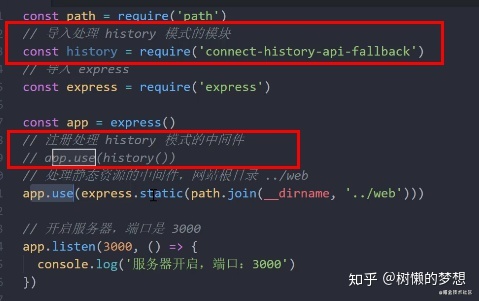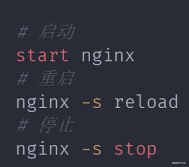有几个关键点需要提前知道:
1、在router/index.js文件内的Vue.use(VueRouter):
(1)Vue.use()是用来注册插件的,它会接收一个参数
(2)如果参数是函数,Vue.use()直接调用这个函数来注册插件
(3)如果参数是对象,Vue.use()直接调用这个对象的install方法来注册插件
2、在router/index.js文件内的const router = new VueRouter({routes})
(1)routes是配置的路由规则是个数组:
const routes = [
{
path: '/',
name: 'Home',
component: Home,
}]new VueRouter()的VueRouter可能是个类,或者是个构造函数,同时里面要有一个静态方法install()
3、在src/main.js文件内的new Vue({router}).$mount('#app')
创建vue实例对象的时候,传入的router对象的作用是:给vue实例对象添加上$router、$route的两个属性
4、Hash 模式和 History 模式的区别
--> 详情点击链接查看 <--
5、在Node.js中使用History 模式

6、在nginx中使用History 模式

在nginx.conf文件中,添加一行代码:

vueRouter的模拟实现
1、用vue脚手架vue-cli4版本的,新建一个项目:
vue create my-vue-router
2、在router文件夹内新建一个myVueRouter.js文件,代码如下:
let _Vue = null // 他就是Vue构造函数
export default class VueRouter {
// install 是静态方法
// 第一个参数是vue的构造函数,第二个参数是可选的选项对象options
static install(Vue) {
// 1、判断当前插件是否已经被注册,在当前类的静态方法上添加一个标记属性installed
if (VueRouter.install.installed) {
retrun
}
// 1、当前插件没有被注册,做个标记,表示已经被注册了
VueRouter.install.installed = true
// 2、把Vue构造函数记录到全局变量中
// 2、因为将来我们要在VueRouter的实例方法中使用Vue的构造函数
_Vue = Vue
// 3、把创建Vue实例的时候,传入的router对象,注入到Vue实例上
// 混入
// 混入的选项,所有的Vue实例中都会有,组件中也会有beforeCreate
_Vue.mixin({
beforeCreate() {
// 只有是Vue实例的时候才会执行这个混入,组件中不需要执行这个混入
if (this.$options.router) {
// this 是对应的Vue实例
_Vue.prototype.$router = this.$options.router
// 给this.$options.router添加一个init()方法
this.$options.router.init()
// console.log(this)
}
},
})
}
// VueRouter的构造函数constructor
constructor(options) {
this.options = options // options是传入进来的路由规则routes
this.routeMap = {} // 是对传入进来的路由规则,解析成对应的键值对,然后保存
this.data = _Vue.observable({
// observable()方法可以创建响应式的对象
current: '/', // 默认是根地址
}) // 存的是当前的路由地址,是响应式的
}
// 遍历路由规则,把解析结果保存在构造函数constructor中的routeMap属性内
createRouteMap() {
this.options.routes.forEach((route) => {
this.routeMap[route.path] = route.component
})
}
// 创建路由使用时候的2个组件 <route-link> 和 <route-view>
// Vue 是Vue的构造函数
initComponents(Vue) {
const self = this
Vue.component('router-link', {
props: {
to: String,
},
// template: '<a :href="to"> <slot></slot> </a>'
render(h) {
// h函数是vue自动传递过来的,h函数有3个参数
// 第一个参数是选择器,
// 第二个参数是给创建的这个dom对象,设置一些属性
// 第三个参数是标签之间的内部内容
return h(
'a',
{
attrs: {
href: this.to,
},
on: {
click: this.clickHandler,
},
},
[this.$slots.default]
)
},
methods: {
clickHandler(e) {
e.preventDefault()
// 判断路由模式是hash模式还是history模式
if (self.options.mode === 'history') {
// 只是改变了url地址栏的url
window.history.pushState(null, null, this.to)
// history模式下,改变url地址栏的url,不会自动调用popstate监听事件
// 所以需要手动设置,把改变后的url地址栏的url赋值给data的响应式数据current,
// 调用router - view去加载对应的页面
this.$router.data.current = this.to
} else {
// 点击router-link,改变url地址栏的url,
// url一改变,hash模式下,就会自动调用hashchange监听事件,
// 在hashchange监听事件内可以得到改变后的url
window.location.hash = this.to
}
},
},
})
Vue.component('router-view', {
render(h) {
// 获取当前路由地址,对应的路由组件
const component = self.routeMap[self.data.current]
return h(component)
},
})
}
// 点击浏览器的前进、后退按钮
initEvent() {
// 判断路由模式是hash模式还是history模式
if (this.options.mode === 'history') {
window.addEventListener('popstate', () => {
this.data.current = window.location.pathname
})
} else {
window.addEventListener('hashchange', () => {
console.log(window.location.hash)
// 把改变后的url地址栏的url赋值给data的响应式数据current,调用router-view去加载对应的页面
this.data.current = window.location.hash.substr(1)
})
}
}
init() {
this.createRouteMap()
this.initComponents(_Vue)
this.initEvent()
}
}3、在router文件夹下的index.js文件内,导入我们自己写的myVueRouter.js文件
import VueRouter from './myVueRouter'
4、可以直接运行项目,查看效果了
npm run serve





















 1019
1019











 被折叠的 条评论
为什么被折叠?
被折叠的 条评论
为什么被折叠?








